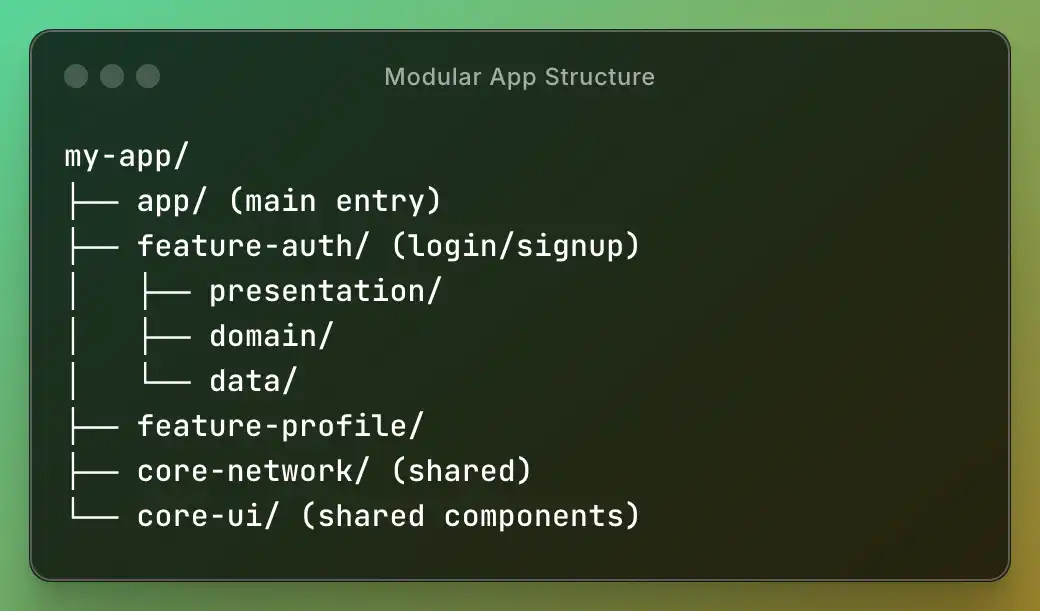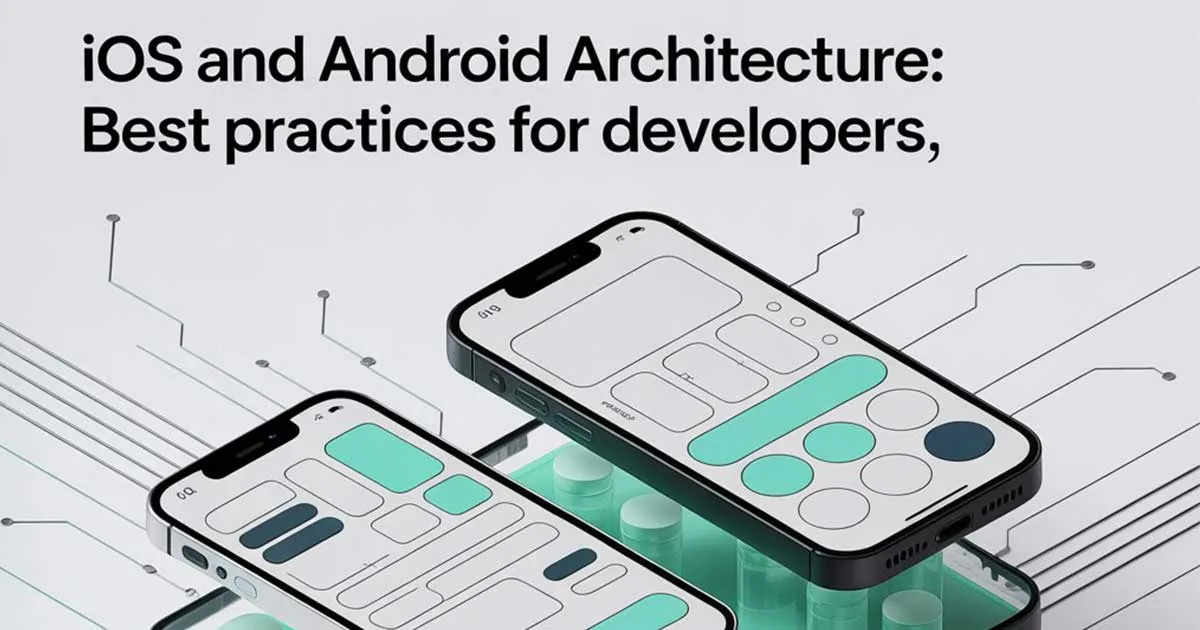iOS and Android Architecture : Best Practices for Developers
1. Why Architecture Matters
In mobile development, architecture is more than a buzzword. It’s the difference between a codebase that scales and one that collapses under pressure. It’s what makes onboarding easier and feature updates safer. For those of us who build across both iOS and Android, understanding their respective architectural foundations helps us make better cross-platform decisions.
Despite the different ecosystems, the architectural goals are often similar: maintainability, testability, and scalability. Over the years, iOS and Android have grown closer in mindset, even if the tools and syntax remain platform-specific.
2. Shared Architectural Principles
2.1. Layered and Modular Design
Both platforms encourage layered design: UI, presentation, domain, and data. Each layer serves a distinct role. This separation reduces coupling and increases clarity.
Components like ViewModels, SwiftUI Views, Composables, and Widgets are now common. Reusability and testability come naturally when logic and UI are clearly separated.
.webp)
Clean Architecture enforces separation, with dependencies flowing inward.
2.2. Separation of Concerns and SOLID
Whether you're writing in Swift or Kotlin, SOLID principles remain relevant. Dependency Inversion and Interface Segregation help reduce entanglement. Code becomes easier to test, reason about, and change.
ViewModels (or Presenters), Use Cases, Repositories, These aren't trends. They're what help us build apps that age well.
2.3. Unidirectional Data Flow
Both iOS and Android are moving towards similar approaches for state management, with SwiftUI combined with Combine or ObservableObject on iOS, and Jetpack Compose on Android. It’s not just a style preference; it’s a strategy for building more maintainable and scalable apps.
3. Entry Points and View Management
3.1. AppDelegate vs MainActivity
iOS : AppDelegate used to handle everything. Now with SwiftUI and SceneDelegate, things are more distributed. Still, it's the place where lifecycles begin and services initialize.
Android : MainActivity feels like the entry point, but AndroidManifest decides the actual starting line. Initialization often happens through DI frameworks.
What’s Different : iOS centralizes app bootstrap. Android splits it more deliberately. The result? iOS starts with a strong central manager. Android leans into component modularity from the start.
3.2. UIViewController vs Activity/Fragment
iOS : UIViewController is responsible for both UI and lifecycle. It’s flexible but can become bloated. We’ve all fought the “Massive ViewController” at some point.
Android : Activity is the host. Fragment is the real workhorse. Android developers often go single-Activity, multi-Fragment. It modularizes better but adds lifecycle management overhead.
The Difference : iOS gives you fine-grained lifecycle control. Android breaks things up for flexibility and reusability. The challenge is different, but the goal "clean UI logic separation" is shared.
4. View Layer and Declarative UIs
4.1. UIKit with Auto Layout vs XML Views
iOS : Auto Layout offers pixel-level control through constraints. It’s powerful but sometimes overkill. Understanding priorities, hugging, and compression resistance takes time.
Android : XML layouts are readable and visual-editor friendly. They're easier for beginners but can lead to deeply nested views. Performance suffers if not managed well.
Summary : iOS uses math and rules. Android uses trees and nesting. Both have their place and pitfalls.
4.2. SwiftUI vs Jetpack Compose
Both Apple and Google are going declarative. SwiftUI and Jetpack Compose represent a huge shift.
SwiftUI : Built on Swift and Combine. You describe what you want; the system renders it. Property wrappers like @State and @Binding manage the data.
Compose : Composable functions, Kotlin Flows, state hoisting. You pass data in, get UI out. Less XML, fewer fragments.
What’s the Point : Declarative UIs reduce boilerplate and favor immutability. You think in terms of state, not instructions.

Declarative UIs prioritize state over imperative commands.
5. Architecture Patterns
5.1. MVC, MVVM, MVI
MVC : Still relevant but tends to blur responsibilities. On iOS, controllers get bloated. On Android, Activities did too.
MVVM : Adds ViewModels for better separation. Makes unit testing easier. Plays well with reactive streams. Both platforms embrace it.
MVI: Focused on unidirectional flow and immutable states. Common in Android due to its functional nature. On iOS, possible via Combine and state structs.
Choosing the Right One
Smaller apps might get away with MVC. Larger teams prefer MVVM or MVI. The real difference lies in state and event management.
5.2. Platform-Specific Evolutions
Android : Jetpack ViewModel, LiveData, StateFlow, tools for reactive, clean architecture.
iOS: Combine, ObservableObject, and now SwiftData. SwiftUI sometimes removes the need for traditional ViewModels.
5.3. Clean Architecture
Clean Architecture brings strong boundaries between layers: UI, Presentation, Domain, and Data. Each layer depends only on the layer inside it, and the Domain layer has no dependencies on the platform. That’s where your business rules live, pure and testable.
We’ve found this especially useful in larger apps or teams, where feature ownership and separation of concerns are key. When onboarding new devs or rewriting legacy features, having a clear structure pays off.
-
Domain Layer: Use Cases, Entities. No platform-specific code.
-
Data Layer: Repositories, network, database.
-
Presentation Layer: ViewModels, Controllers, or Presenters.
-
UI Layer: SwiftUI Views, Jetpack Compose, UIKit, or XML.
Clean doesn’t mean complex. It’s about drawing lines in the sand so that in the future you (or your teammates) don’t have to guess where logic belongs.

Modular design improves build times and team scalability.
6. Tools and Strategies
6.1. Dependency Injection
DI is essential in modern mobile architecture. It supports testability and flexibility.
Android : Hilt, Dagger, Koin. Setup might be verbose, but the result is clean separation.
iOS : Fewer standard tools. Many teams roll their own or use Swinject. Swift’s lack of reflection adds friction.
-Setup.webp)
Real-World Impact
In my experience, architecture is less about picking the right buzzword and more about helping your team move with confidence. We aim for clarity, not ceremony. If something is easy to test, easy to replace, and doesn’t slow us down, we’re on the right path.
When you’ve worked deep on both iOS and Android, you start to notice how much they’ve grown toward each other. Different APIs, yes. Different tools, sure. But the core ideas? Pretty aligned. ViewModels, dependency injection, unidirectional data flow... they’re not just trendy. They work.
That mindset helps me stay focused on building clean, resilient apps across platforms. And honestly, it makes the job more enjoyable.

